Exploring Real Quartz Crystals: Types and Tips


Intro
In the realm of gemstones and minerals, quartz crystals hold a prominent place, often revered for their beauty and multifaceted characteristics. Whether they are sought for collection, use in healing practices, or simply admired for their natural allure, understanding the full spectrum of real quartz crystals can feel like an expedition into the heart of the Earth's history. This article will take you on a journey through the various aspects of real quartz crystals, from their fascinating origins to the considerations for authenticating and purchasing them. With knowledge comes power, and by the end of this read, you'll be equipped to navigate the quartz market like a seasoned collector.
History and Origins
Overview of Collectibles, Rocks, and Fossils
The fascination with minerals isn’t a novel trend. Throughout human history, rocks and crystals have been collected not just for aesthetic purposes but also for their perceived mystical properties. Quartz, one of the most abundant minerals on Earth, has been used since ancient times. Early civilizations utilized quartz for tools and in religious ceremonies. From the light-catching clarity of clear quartz to the rich hues of amethyst, these stones have been woven into the fabric of culture. Collecting quartz crystals is like holding a piece of geological history in your hand; each stone tells a story of ancient geological processes.
Historical Significance and Cultural Impact
Various cultures have attached significant meaning to quartz crystals. For instance, in ancient Egypt, the clarity of quartz was associated with the idea of clarity of mind and spirit. The Greeks believed quartz crystals could provide strength; they even thought the word "crystal" derived from the term "kristallos," meaning "frozen". Beyond just ancient history, the modern metaphysical community elevates quartz crystals to new heights, claiming they can amplify energy and promote healing. This long-standing cultural reverence suggests that quartz crystals are not merely collectibles but artifacts imbued with meaning and significance.
Identification and Classification
Guide to Identifying Rocks and Fossils
Identifying real quartz crystals requires a discerning eye, but a few tips can help you separate the genuine article from imitations. First off, consider the clarity of the stone. Real quartz often displays clarity, though variations such as smoky or rose quartz can distort this feature.
Look for inclusions—natural imperfections that confirm authenticity. A proper examination under light can often reveal unique characteristics. If a stone glows under ultraviolet light or has a too-perfect cut, it's likely synthetic.
Common Types and Variations
There are several recognized types of quartz, each with distinct features:
- Clear Quartz: Known for its transparency and often used for healing and energetic work.
- Amethyst: Valued for its deep purple shade and believed to promote calmness.
- Rose Quartz: Beautifully pink, often associated with love and emotional healing.
- Smoky Quartz: Offers a darker hue, said to ground energy and provide protection.
- Citrin: Reddish-yellow crystal often used for abundance and prosperity.
Understanding these different types can enhance your collecting experience and guide you in making educated purchases.
"Collecting is not just about the acquisition; it’s about the stories behind each piece."
By diving into the world of quartz crystals, you're not merely accumulating objects; you are becoming part of an expansive narrative that transcends time and culture. It's a journey that educates and enriches, providing deeper insights into both the earth and our connection to it.
Preface to Real Quartz Crystals
When tapping into the world of quartz crystals, one must appreciate their widespread appeal and significant value across various contexts. Real quartz crystals serve not just as stunning collectibles, but also embody a rich tapestry of geology, spirituality, and craftsmanship. For enthusiasts ranging from casual hobbyists to serious collectors, understanding real quartz is crucial. This section aims to delineate the essence of quartz crystals, touching upon their origins, varieties, and the key considerations when engaging in the quartz marketplace.
Quartz is not just another pretty rock; it possesses unique properties that resonate deeply with cultural and metaphysical beliefs. For instance, many people regard quartz as a powerful tool in wellness practices, using its perceived energetic qualities to promote healing and balance. This has sparked a rising interest among individuals eager to incorporate crystals into their lives, both decoratively and spiritually.
Moreover, the process of acquiring authentic quartz crystal is essential for any collector. One needs to navigate a myriad of options—from local gem fairs to online retailers—while discerning genuine products from mass-produced imitations. Potential buyers should not skim over aspects such as clarity, authenticity, and the seller's reputation. Understanding these elements enhances the value of the crystal experience and ensures that collectors are getting their money's worth.
Gathering these gems is not simply about forming a collection; it is about connecting with the earth and embracing a little piece of its history. Real quartz crystals come with tales of their formation over millions of years, and such stories add to their allure. Thus, understanding the significance and sourcing of these crystals enhances one's inner awareness and knowledge, making for a fulfilling collecting journey.
"A crystal is not just an object. It connects you to the universe in ways you may not even be aware of."
Engaging in the exploration of real quartz crystals opens doors to myriad possibilities, from admiring their natural beauty to discovering how they can play a role in wellness practices. Considering all the aforementioned factors, this article aims to guide readers through the multifaceted world of quartz crystals, increasing both their appreciation and understanding.
Understanding Quartz: The Basics
When it comes to the realm of minerals, quartz is like the stock market's blue chip—stable, versatile, and continually in demand. Grasping the essentials of quartz is paramount, as it lays the groundwork for deeper discussions about types, uses, and market dynamics concerning real quartz crystals. Coined by the Germans as "quarz" in the 16th century, this silicate mineral doesn't just sparkle; it carries a bonafide legacy across centuries.
Quartz is the second most abundant mineral in the Earth's crust. It serves as the backbone for various procedures, from shattering light into a spectrum for artists, to ensuring the precision of your wristwatch. It's seen everywhere—from your smartphone to majestic jewelry pieces. This widespread occurrence implies that distinguishing authentic quartz from its synthetic counterparts becomes crucial, especially for collectors who value history embedded in each stone.
In seeking to acquire real quartz, knowing the fundamentals equips you not only with knowledge but with confidence. This awareness enables you to appreciate the various types on the market, understand their unique properties, and recognize their intrinsic value. Here’s a further breakdown:
- Educational Value: Knowing the basics sets the stage for making informed purchasing decisions. You wouldn't want to invest in something that's as fake as a three-dollar bill.
- Versatility in Uses: From healing practices to decorative items, being aware of different quartz types opens avenues for their application in daily life.
- Navigating Market Challenges: With the rise of imitation products, being well-versed in the properties of quartz becomes your shield against fraud.
In summary, understanding quartz equips the reader not only with basic gemology knowledge but also paves the road for successful transactions, enhancing one’s appreciation for these marvelous crystals.
What is Quartz?
At its core, quartz is a mineral composed of silicon and oxygen, two of the most abundant elements in the Earth's crust. Often appearing as clear or milky stones, quartz typically forms in a hexagonal structure, showcasing its uniqueness. It’s one of those terms that get thrown around in the gem and mineral world, but its significance is deeper than just being “shiny.”
The intricacies of its formation are intertwined with geological processes, causing it to exhibit a variety of colors and structures, often influenced by the presence of other minerals during its crystallization. In essence, quartz transforms private Earthly process into objects of beauty, making it coveted across different cultures and practices throughout history.
Classification of Quartz Crystals
Quartz isn’t a one-size-fits-all category. There’s a plethora of varieties, each possessing distinct characteristics and connotations in the spiritual and practical realms. Here’s a quick rundown of some of the most sought-after types:
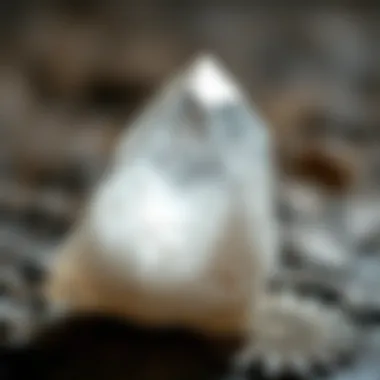
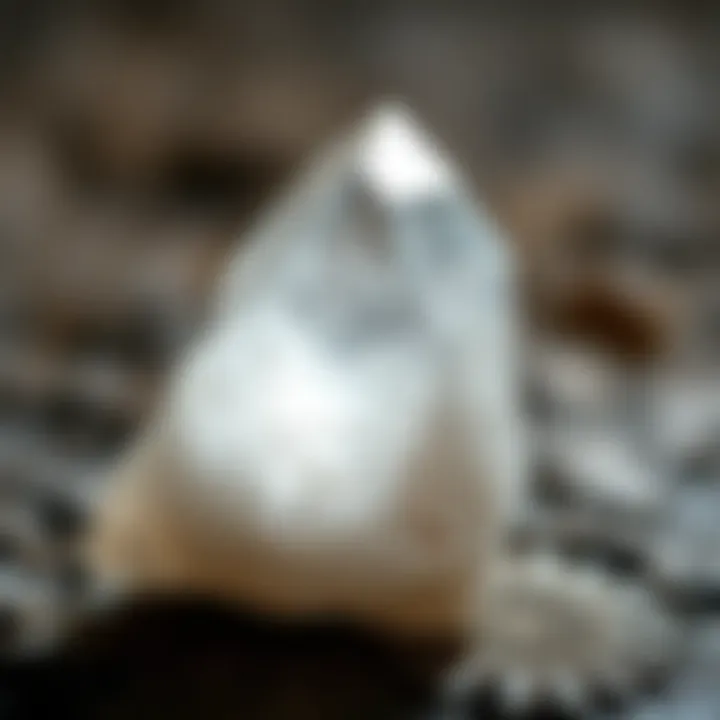
Clear Quartz
Clear quartz, often dubbed the "master healer", is like the Swiss Army knife of crystals. It boasts clarity that lets in light, making it incredibly aesthetic. One of its standout attributes is its ability to amplify energy, which collectors find particularly appealing for energetic cleansing or during meditation. However, this transparency might deceive some into thinking it lacks personality.
"Clear quartz is not merely about its appearance; it resonates with versatility—enhancing other crystals’ energies around it."
The key characteristic of clear quartz is its optical clarity, reflecting a kind of purity that beckons collectors. However, its common nature might dilute its value compared to more colorful varieties. Plus, an abundance on the market leads to buyers needing to scrutinize sellers diligently.
Amethyst
Amethyst is the purple crown jewel among quartz crystals. Its rich hue speaks volumes, representing tranquility and spiritual wisdom. This particular variety gains its color from iron impurities and natural radiation—a fascinating fact that showcases nature’s creativity. Amethyst has gained recognition as a go-to stone for those who seek calming energies and clarity of thought.
A collector might be drawn to its striking color and supposed metaphysical properties, but it also gets its fair share of fake looks in the market, often created from heat-treated quartz. It’s essential for buyers to verify the source of their amethyst, ensuring they’re acquiring genuine pieces.
Citrine
Citrine is often called sunshine bottled, brightening even the dullest room. This warm yellow to brownish color isn’t just for aesthetics; it symbolizes prosperity and success across various cultures. Particularly interesting about citrine is its physical makeup—unlike other quartz varieties, natural citrine is relatively rare, with many of the gems on the market actually being heat-treated amethyst.
This presents both pros and cons; on one hand, its rarity makes it sought after, while on the other, those unversed might unknowingly pay top dollar for fakes. Collectors must be savvy, seeking certified citrine for genuine and valuable specimens.
Rose Quartz
Rose quartz embodies love in its purest form, often recognized for its soft pink shades. This crystal is synonymous with balance, compassion, and emotional healing. Not just visually appealing, it’s frequently used in practices aimed at self-love and fostering deeper connections with others. The light hues can range from pale to deeper pink, often marked by a milky translucence that provides a unique touch.
The main attraction of rose quartz lies in its aesthetic as well as its perceived benefits for emotional well-being. However, buyers should be cautious, as its popularity has led to a rise in synthetic counterparts that imitate its delicate appearance but lack its energetic properties.
In essence, each type of quartz bears its own story and purpose. Understanding these classifications enriches not just the collector's knowledge, but also enhances the overall experience of engaging with these magnificent minerals.
The Market for Real Quartz Crystals
The market for real quartz crystals is a vibrant tapestry interwoven with trends, preferences, and consumer awareness. Understanding this market is crucial for anyone wanting to acquire genuine quartz crystals, whether for personal collection, healing practices, or artistic endeavors. With various options available, buyers must navigate a landscape filled with sellers, each hawking their wares like peddlers in an old bazaar. It’s essential to know where to shop and how to gauge the quality of the stones, as well as the integrity of the sellers. In essence, this section serves to illuminate the pathways towards obtaining authentic quartz while shedding light on potential pitfalls.
Where to Buy Real Quartz Crystals
Gem Shows and Fairs
Gem shows and fairs offer a unique shopping experience pertinent to those passionate about mineral collecting. These events are like treasure hunts, organized across various venues mostly in big cities. Vendors from all over gather to display their stones, often providing a space for buyers to learn and interact with sellers face-to-face. One key characteristic of these shows is the chance to see a variety all in one place. They often have a lively atmosphere that is infectious.
However, attending a gem show can be time-consuming and sometimes overwhelming. The sheer number of options might create a bit of buyer's fatigue. Still, the benefits are undeniable. You get hands-on experience with the crystals, can ask questions directly, and might even score some special deals.
Online Marketplaces
The rise of online marketplaces has revolutionized how people acquire quartz crystals. Websites like Etsy, eBay, or specialized crystal shops provide a breadth of choices from the comfort of home. The main advantage of online shopping is convenience; you can browse selections at your leisure without geographical limitations.
Yet, this convenience comes with its own set of challenges. Not every seller online is reputable, and the risks of receiving synthetic or misrepresented stones can be significant. Shoppers may find it hard to assess the quality accurately, as pictures can't convey the full physical characteristics of the crystal. Therefore, doing your due diligence is essential.
Specialty Shops
Specialty shops dedicated to gemstones and crystals provide a curated experience. Unlike general retailers, these shops often have knowledgeable staff who can offer insights and advice tailored to your specific needs. The unique feature of specialty shops is the personal touch they bring to the buying process. You will likely encounter staff who are as passionate about crystals as you are.
However, specialty shops may not always be accessible for everyone, given their localized nature. Additionally, prices may be higher than those at a gem show or online marketplace due to the personal service they provide. But for many collectors, the ability to ask questions and receive expert guidance is worth the potential price difference.
Evaluating Sellers
Reputation and Reviews
When embarking on the quest for real quartz crystals, evaluating sellers cannot be overstated. The reputation of a seller serves as your compass in this market. A good reputation often signals reliability. Checking reviews from previous customers helps mitigate the risk of purchasing low-quality stones.
The beauty here lies in transparency, as many sellers on established platforms display their ratings prominently. However, one must be cautious; a shiny rating doesn’t always guarantee satisfaction. It’s wise to delve deeper into written reviews to gauge reliability of the seller more accurately.
Certifications
Certifications can function like a seal of authenticity in the crystal market. Some sellers may offer certificates that confirm the crystal's origin and quality. This aspect is especially crucial for rarer varieties of quartz since provenance can significantly influence value. While not all legit crystals come with certification, having one can lend credibility to the purchase.
But remember, not all certifications are created equal. Some might come from obscure sources, adding little value. Buyers should know that while certificates may enhance trust, it’s best to combine this with other forms of evaluation.
Return Policies
Lastly, understanding return policies is essential. A trustworthy seller typically has a clear and fair return policy, allowing customers peace of mind in their purchases. The ability to return a crystal if it turns out not to be what you expected can make a significant difference in the buying experience.
Some sellers might only offer returns under certain conditions or a limited time. Knowing these details ahead of time can prevent unpleasant surprises later. It’s worth asking any seller about their return policy before completing a purchase, as this can reveal their confidence in their own products.
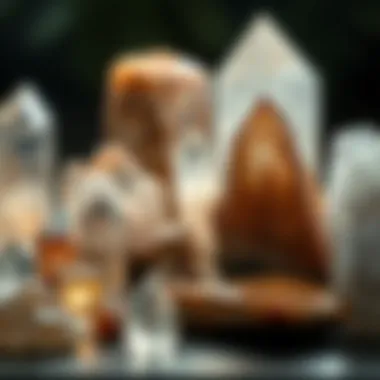
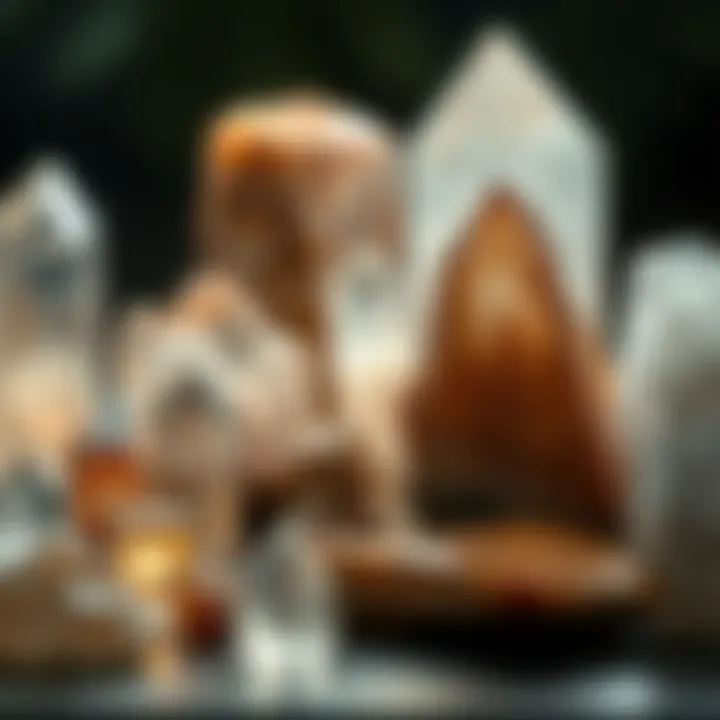
Take note: Always prioritize sellers who show a commitment to customer satisfaction and transparent policies.
Thus, finding real quartz crystals in today’s market involves more than merely choosing a vendor; it requires an informed approach to evaluation and understanding personalities behind each selling entity.
Assessing Authenticity of Quartz Crystals
Determining the authenticity of quartz crystals is crucial for any collector. With the increasing popularity of crystals in various sectors, be it for therapy or decoration, one must tread cautiously through the marketplace. Understanding how to assess authenticity ensures that your investment is sound and that you'll not be caught off guard by synthetic or treated pieces that might lack the true essence of what you're seeking. Knowing the characteristics to look for can save you time, money, and disappointment.
Physical Characteristics to Inspect
Clarity and Inclusions
When it comes to clarity in quartz crystals, this characteristic marks the distinction between an amateur and a seasoned collector. Clarity refers to how transparent or clouded a crystal appears. Real quartz crystals often display natural inclusions, which can be gas pockets, minerals, or even tiny bubbles. These inclusions serve as fingerprints—unique identifiers that reflect the crystal’s geological journey. High clarity might be sought after, but these inclusions tell a story about the crystal’s origin and authenticity.
- Key trait: Natural inclusions enhance uniqueness
- Advantage: Adds to its charm and value
For example, a clear quartz piece with feathery-like inclusions can be far more compelling than a perfectly clear specimen. Such nuances seem less common in synthetic alternatives, making inclusions a beneficial hallmark of authenticity.
Color Variations
The beauty of quartz is enriched by its wide spectrum of colors, ranging from the deep purple of amethyst to the soft pink of rose quartz. Color variations can greatly influence the perceived value and desirability of a crystal. Genuine quartz typically showcases a depth of color that is consistent throughout the stone. If you notice an unnatural sheen or right sharp transitions between colors, consider that a red flag.
- Key trait: Variations can reveal the crystal's authenticity
- Disadvantage: Some synthetics can mimic these hues
Collectors should be vigilant about color. For instance, natural citrine often has orange hints, whereas a synthetic piece might present a more vibrant yellow without the subtleties indicative of natural formation.
Surface Texture
Surface texture isn’t just about looks; it tells much about how a crystal has been formed. When examining quartz crystals, observe the texture carefully. Real pieces often have surfaces that are a bit rough or jagged. A synthetic piece, on the other hand, may appear too polished or flawless.
- Key trait: Natural 'roughness' signals authenticity
- Advantage: Marks its journey through nature
For example, a raw amethyst may have irregular edges that reflect its natural breakdown over time. In contrast, overly polished edges could suggest man-made processes, lessening its allure.
"With every tiny flaw and unique mark, a crystal carries its tale of creation and transformation, something that is often lost in synthetic versions."
Common Misconceptions About Synthetic Quartz
Within the realm of quartz, misconceptions often abound. A pervasive belief is that synthetic quartz, while aesthetically pleasing, holds the same value as its natural counterparts. However, they lack the historical and geological significance, therefore diminishing their value in geological circles. Furthermore, while synthetic crystals can exhibit consistent looks, they simply cannot provide the sellers or buyers with the same authentic experience that comes from handling natural specimens.
To ensure that you're making informed decisions when collecting quartz crystals, always evaluate the clarity, color, and surface texture. This meticulous examination may very well enhance your collection while assuring you of gaining genuine pieces.
Valuation of Quartz Crystals
Valuation of quartz crystals holds significant importance for both collectors and those interested in their therapeutic properties. Unlike mere decorative pebbles, quartz crystals offer a unique blend of aesthetic beauty and personal significance, making their worth highly variable. Understanding how to assess the value helps buyers avoid overspending and sellers maximize their returns. Knowing the ins and outs of this topic grants a clearer picture of what makes a quartz crystal not just appealing but special.
Factors Affecting Value
Rarity
Rarity plays a pivotal role in determining the value of quartz crystals. Some types, like the rare pink amethyst, are sought after; thus, they command higher prices. The characteristic feature of rarity resides in its supply-demand relationship. If a particular type of quartz crystal isn’t widely available but has high demand, its value skyrockets. In the realm of quartz, scarcity can be due to geographical limitations or natural occurrences that hinder extraction. It's important for buyers to note that rarer stones can sometimes present a mixed bag—while they can appreciate significantly in value, they might also be harder to source in the future.
Size and Weight
The size and weight of quartz crystals are often straightforward indicators of their value. Large specimens tend to be more desirable, as they are easier to showcase. With size comes presence and visual impact, qualities that collectors cherish. A key characteristic here is that heavier stones often signify higher value since larger pieces tend to be rarer. However, there is a catch—extra weight can sometimes introduce challenges like handling and display. Someone managing a sizeable quartz collection needs to think about logistics as well as aesthetics before diving into hefty purchases.
Quality
Quality, an all-encompassing term, refers to various aspects of a quartz crystal’s appearance and condition. It includes clarity, the vibrancy of color, and the absence of cracks or other flaws. A high-quality quartz crystal can significantly increase in value compared to a lesser-quality counterpart. Buyers often look for clear quartz with minimal inclusions when searching for high-value specimens that can command a premium. Conversely, low-quality crystals may appeal to budget-conscious buyers but will not hold much long-term value. Keeping an eye on quality is vital for collectors aiming for a well-rounded and enriching collection.
Market Trends and Pricing
Understanding market trends and pricing is crucial for anyone involved in quartz crystal collecting. The prices can fluctuate widely depending on consumer interest, seasonal changes, or even global supply chain issues. Over the past few years, certain types have gained traction, reflecting broader wellness trends emphasizing metaphysical properties.
- Emerging Trends: Whether it’s raw crystals or polished pieces, the aesthetic preferences in the market show a shift towards more natural forms.
- Seasonal Pricing: Prices might rise during holiday seasons or events focused on wellness and spirituality.
- Online Impact: The rise of social media platforms has made it easier for buyers to connect with sellers, broadening market accessibility.
By staying tuned to these trends, collectors can make informed decisions, potentially striking deals that reflect the true value of their quartz crystals.
"The world of quartz crystals is both fascinating and intricate. Knowledge about valuation can turn a simple interest into a lifelong passion."
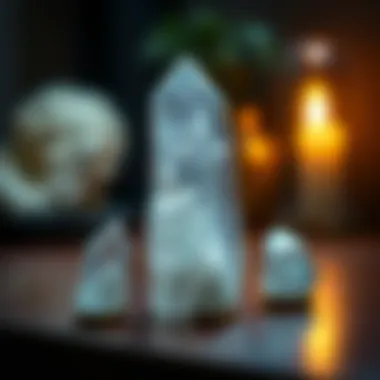
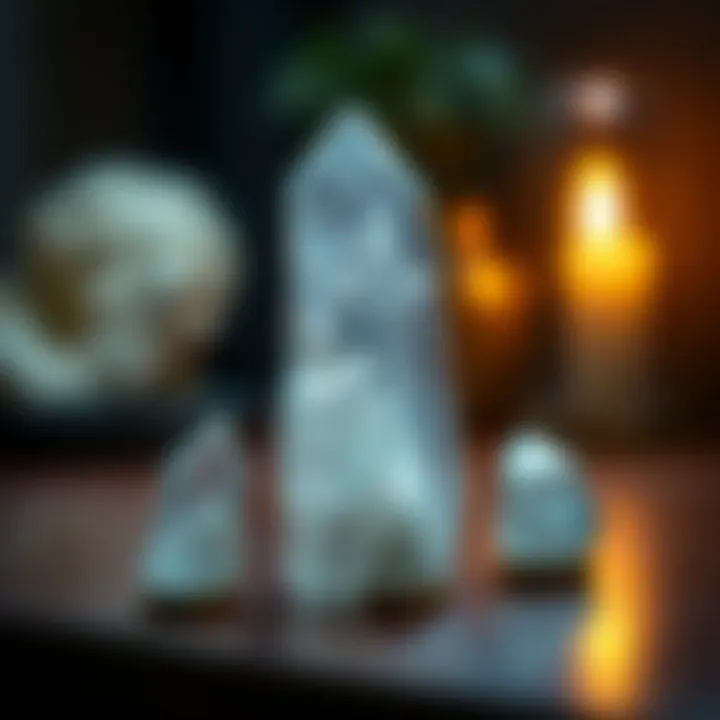
In sum, knowing how to assess the valuation of quartz crystals enriches the collector experience immensely. It allows for informed buying and selling, helping ensure a collection that not only looks appealing but holds meaningful value.
Caring for Your Quartz Crystals
Taking care of your quartz crystals is vital for maintaining their beauty, integrity, and value over time. These natural wonders deserve careful treatment, as improper handling can lead to scratches, dulling, or even chips that can mar their aesthetic appeal. Furthermore, adhering to proper care practices can enhance the energy they are said to radiate, especially important for those who incorporate them into healing and wellness routines.
When considering how to care for quartz, paying attention to cleaning and storage methods can go a long way. In this part of the article, we will delve into effective cleaning techniques and offer advice on proper storage and display. By doing so, you can not only preserve the physical characteristics of these crystals but also maximize their potential benefits in your daily life.
Cleaning Techniques
Cleaning quartz crystals is essential for removing dirt, oils, and any negative energy they may accumulate. There are several satisfactory cleaning methods that one can adopt, depending on the type of quartz and its unique properties. Here are a few notable techniques:
- Water Cleaning: A simple and effective method is rinsing the crystal under cool running water. This is particularly suitable for sturdy varieties like clear quartz and smoky quartz. However, one must be cautious with more delicate crystals, as water can deteriorate their surface over time.
- Saltwater Bath: For energetic cleansing, a saltwater bath can be useful. A single teaspoon of sea salt dissolved in a bowl of water can effectively cleanse your quartz. Just be mindful to use this method sparingly on more porous stones, as the salt can be too abrasive.
- Smudging: Burning sage or palo santo and passing your crystal through the smoke adds a spiritual layer of cleansing. This practice is popular among those who believe in the energetic properties of quartz, allowing it to restore its vibrational alignment.
- Sonic Cleaners: For those who desire a deep clean, ultrasonic cleaners are available. They can meticulously clean even the most intricate facets of quartz crystals. While effective, caution is advised, ensuring that your chosen crystal can withstand the vibrations and water exposure.
Storing and Displaying
Best Practices
When it comes to storing quartz crystals, applying thoughtful best practices can greatly enhance their longevity.
- Separate Storage: It’s best to store each crystal separately, ideally in its own soft pouch or a dedicated display case. This avoids scratches and keeps their surfaces unmarred.
- Temperate Environment: Keep crystals in a stable environment away from extreme temperatures. Excessive heat or humidity can affect their quality.
- Avoid Direct Sunlight: While many crystals benefit from sunlight, prolonged exposure can fade colors, especially in varieties like amethyst or citrine. A dimly lit area is often more suitable.
These best practices don’t just protect your crystals; they also contribute positively to your overall collection. Proper care creates an inviting display and highlights the magnificence of each piece.
Avoiding Damage
Caring for your quartz means being mindful about avoiding potential damage as well.
- Touching and Handling: Limit how often you touch your crystals. The oils from your fingers can accumulate and impact their radiance. If handling is necessary, always ensure your hands are clean.
- Jewelry Care: If you use quartz in jewelry, ensure that it's not worn during strenuous activities, as this can lead to scratches or breakage. It can be wise to store your crystal jewelry in a soft-lined box when not in use.
By focusing on avoiding damage, you create a more sustainable collection that stands the test of time. This approach may seem simple, but awareness of your environment and handling methods can greatly extend the life of your cherished quartz crystals.
In essence, caring for your quartz crystals entails a partnership between proper cleaning, mindful storage, and an awareness of potential hazards. By following these guidelines, one ensures that these beautiful pieces of nature not only retain their physical charm but also continue to fulfill their intended purpose in your life.
The Significance of Quartz Crystals
Quartz crystals hold a substantial position in both historical and modern contexts, reflecting deep cultural significance and diverse utility that render them invaluable to many. This section highlights not only their rich historical narrative but also their multifaceted contemporary applications, ensuring the reader grasps just how profound quartz crystals are in a variety of fields.
Cultural and Historical Importance
Throughout civilization, quartz crystals have been revered across many cultures. Historically, these beautiful minerals were believed to possess magical properties, often regarded as conduits for power and spirit. For ancient Egyptians, quartz served both as a tool for protection against evil spirits and a means to enhance clarity of thought. Similarly, in ancient China, the crystals were thought to harness the energy of the Earth, often used in rituals for divination and healing.
These beliefs underscore a significant cultural facet: quartz crystals were often more than mere objects; they held symbolic weight, marking them as a bridge between the physical and spiritual realms.
In modern times, quartz continues to pulsate with cultural relevance. Its use in jewelry-making, art, and spiritual practices maintains this ancient reverence. Artists and craftspeople draw upon quartz’s inherent beauty to create works that resonate on an emotional level, fostering a connection between the craftsmanship and the natural world.
Quartz crystals have been cherished not just as beauty but as tools for insight, healing, and connecting with higher energies.
Uses in Modern Practices
The present-day utility of quartz crystals spans from therapeutic applications to artistic endeavors, showing their versatility and enduring charm.
Healing and Wellness
In the realm of healing and wellness, quartz is lauded for its reputed ability to stabilize energy. Practitioners of crystal healing often harness its energy to promote physical and emotional balance. For example, rose quartz is celebrated for its association with love and compassion, making it a popular choice among individuals seeking emotional healing in troubled times. Practitioners assert that holding or meditating with quartz can enhance clarity, reduce stress, and even assist in physical healing processes.
One key characteristic of quartz in wellness practices is its accessibility. As it is widely available and affordable, it serves as an ideal option for those new to crystal healing or individuals wishing to incorporate these practices into their daily lives. However, one should remain cautious, as the efficacy of quartz crystals is often viewed through a lens of personal belief rather than scientific validation.
Art and Craft
In the artistic domain, quartz crystals are not merely for their metaphysical properties; they are often incorporated into artworks and crafts due to their aesthetic appeal. Artists frequently use quartz to infuse their works with natural beauty, texture, and color. For instance, polished quartz can serve as stunning focal points in sculptures or mixed media projects, adding a dimensional aspect that draws the viewer’s eye.
A standout aspect of incorporating quartz in art is the range of choices (the different types transforming the artistic vision). From the vibrant purple hues of amethyst to the soft pinks of rose quartz, the hues and characteristics can create diverse expressive qualities. However, there can be challenges as well; sourcing genuine quartz for high-quality pieces can pose difficulties, and counterfeit stones may find their way into the market, affecting the integrity of the artist's work.
Ending
In wrapping up the exploration of real quartz crystals, it's crucial to recognize not only the beauty they possess but also the significance they hold within both personal and broader societal contexts. The journey from understanding the basic nature of quartz to its cultural importance sheds light on why these natural wonders are so cherished.
The topic covered considers various facets: the availability of authentic quartz crystals, the nuances of market value, and the intricate process of authentication. Each element plays a vital role in informing collectors, whether they are just starting or are seasoned veterans in the hobby.
When it comes to purchasing quartz crystals, understanding the variety and assessing authenticity are indispensable skills. A potential buyer should be prepared to discern between the abundant synthetic reproductions and the genuine articles that carry historical and sentimental weight. By equipping oneself with the knowledge shared in this article, individuals can make informed decisions, ensuring they acquire pieces that truly resonate with their personal or therapeutic needs.
Moreover, the historical significance of quartz crystals cannot be understated. Across diverse cultures, they have served both practical and mystical purposes, from being used in ancient rituals to contemporary practices surrounding wellness. This intertwining of the past with modernity offers a rich narrative that enhances the overall appreciation of quartz.
Lastly, as quartz enthusiasts delve deeper into their collections, the understanding of proper care and maintenance further solidifies their connection to these stunning minerals. Whether displayed prominently or stored thoughtfully, each crystal tells a story worth preserving.
In essence, by recognizing the factors influencing availability and value, understanding their potential uses, and appreciating their significance, collectors can cultivate a fulfilling relationship with real quartz crystals that extends far beyond mere acquisition. This journey through the world of quartz is not just about the stones themselves; it's about the connections they help forge with ourselves and our environment.



